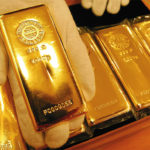 Gold futures rose on Tuesday as market players weighed the prospect of Fed stimulus cuts against possible military conflict between Russia and Ukraine. Meanwhile, assets in the SPDR Gold Trust, the biggest bullion-backed ETF, rose yesterday to the highest level since December 20.
Gold futures rose on Tuesday as market players weighed the prospect of Fed stimulus cuts against possible military conflict between Russia and Ukraine. Meanwhile, assets in the SPDR Gold Trust, the biggest bullion-backed ETF, rose yesterday to the highest level since December 20.
On the Comex division of the New York Mercantile Exchange, gold futures for settlement in April rose 0.13% to trade little changed at $1 343.30 per troy ounce by 07:50 GMT. Prices touched a session high at $1 344.10 per troy ounce, while day’s low was touched at $1 338.10 an ounce.
The precious metal capped a fifth weekly gain last week, jumping to more than 4-month high of $1 355.00 per troy ounce on March 3, as tensions between Russia and Ukraine escalated, spurring demand for haven assets, including gold.
Gold futures are up 11% this year and capped the first back-to-back monthly increase in February since the two-months through August, after a recent unrest in emerging markets, including Ukraine, and signs of slowing US growth, boosted demand for bullion as a store of value.
On March 3rd, pro-Russian forces seized control of the southern Ukraine’s Crimea region in what turns out to be the worst conflict between the West and Russia since the Cold War era. As Russia tightened its hold on the Ukrainian region, the later decided to begin military exercises, adding to the rising tension between the two countries.
“Gold looks like it’s stuck in range-trading,” said Mark To, head of research at Wing Fung Financial Group, a Hong Kong-based trader and refiner, cited by Bloomberg. “The market will look to data for clues whether the Federal Reserve will continue to taper, while tension between Russia and Ukraine will help keep prices supported”, To said in a report.
Fed stimulus outlook
Bullion prices were pressured yesterday after two Fed officials commented that the hurdle rate to alter the pace of Fed stimulus cuts was too high.
Fed President of Philadelphia Charles Plosser, who is a voting member this year, commented yesterday that the recent batch of strong US economic data wasnt enough to alter the pace of the central bank asset purchases. His statement was later echoed by Chicago Fed President Charles Evans, who will not vote on policy this year.
“Given the fact that we’ve embarked on measured reductions, it’s important to give some certainty or at least clarity to the markets on what we’re doing,” Plosser said in a Bloomberg interview. “It’s OK to continue at 10 billion. The hurdle rate for change is pretty high in either direction.”
Federal Reserve Chair Janet Yellen said last month that central bank’s officials were “open to reconsidering” the pace of reductions in monthly bond purchase, should the economy falter, in contrast with her comments made earlier in February, that US economy has gained enough strength in order to withstand reduction of monetary stimulus.
At the same time, Fed officials will try to determine whether the weakness economy has recently demonstrated is due to temporary factors, before their next policy meeting scheduled for March 18-19th.
“Unseasonably cold weather has played some role,” Yellen said in her testimony in front of the Senate Banking Committee in February. “What we need to do, and will be doing in the weeks ahead, is to try to get a firmer handle on exactly how much of that set of soft data can be explained by weather and what portion, if any, is due to softer outlook.”
The central bank announced in December that it will pare monthly bond-buying purchases by $10 billion, after which it decided on another reduction of the same size at the meeting on policy in January, underscoring that labor market indicators, which “were mixed but on balance showed further improvement”, while nation’s economic growth has “picked up in recent quarters.”
Federal Reserve will probably continue to pare stimulus by $10 billion at each policy meeting before exiting the program in December, according to a Bloomberg News survey of 41 economists, conducted on January 10th.
Assets in the SPDR Gold Trust, the biggest bullion-backed ETP, were increased to 812.70 tons on Monday, the strongest level since December 20th. Holdings in the fund are 0.9% up this year after it has lost 41% of its assets in 2013, that wiped almost $42 billion in value. A total of 553 tons has been withdrawn last year. Billionaire hedge-fund manager John Paulson who holds the biggest stake in the SPDR Gold Trust told clients at the end of last year that he wouldn’t invest more money in his gold fund because it isn’t clear when inflation will accelerate. However, a government report revealed that the owner of the largest stake in the SPDR Gold Trust, kept his holdings unchanged in the fourth quarter of 2013.





